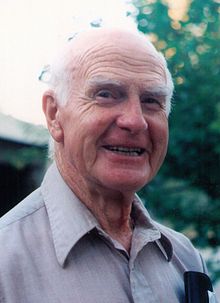Edward Creutz | |
|---|---|
 Creutz in later life | |
| Born | January 23, 1913 |
| Died | June 27, 2009 (aged 96) |
| Citizenship | American |
| Alma mater | University of Wisconsin–Madison (B.S. 1936, Ph.D. 1939) |
| Scientific career | |
| Fields | Nuclear physics |
| Institutions | Metallurgical Laboratory Los Alamos Laboratory Carnegie Institute of Technology General Atomics |
| Thesis | Resonance Scattering of Protons by Lithium (1939) |
| Doctoral advisor | Gregory Breit |
Edward Creutz (January 23, 1913 – June 27, 2009) was an American physicist who worked on the Manhattan Project at the Metallurgical Laboratory and the Los Alamos Laboratory during World War II. After the war he became a professor of physics at the Carnegie Institute of Technology. He was Vice President of Research at General Atomics from 1955 to 1970. He published over 65 papers on botany, physics, mathematics, metallurgy and science policy, and held 18 patents relating to nuclear energy.
A graduate of the University of Wisconsin–Madison, Creutz helped Princeton University build its first cyclotron. During World War II he worked on nuclear reactor design under Eugene Wigner at the Metallurgical Laboratory, designing the cooling system for the first water-cooled reactors. He led a group that studied the metallurgy of uranium and other elements used in reactor designs. In October 1944, he moved to the Los Alamos Laboratory, where he became a group leader.
After the war ended, Creutz accepted an offer to come to the Carnegie Institute of Technology, where he became the head of its physics department and its nuclear research center in 1948. In 1955 he returned to Los Alamos to evaluate its thermonuclear fusion program for the Atomic Energy Commission. While there he accepted an offer to become vice president for research and development and the director of its John Jay Hopkins Laboratory for Pure and Applied Science at General Atomics. Under his leadership, General Atomics developed TRIGA, a nuclear reactor for universities and laboratories.
Creutz served as an assistant director of the National Science Foundation from 1970 to 1977, and then as director of the Bernice Pauahi Bishop Museum in Honolulu, where he took particular interest in the museum's preparation of a Manual of the Flowering Plants of Hawaii.
